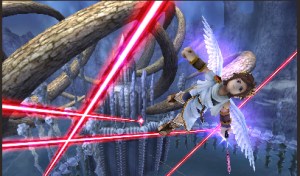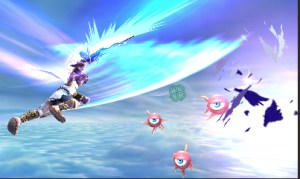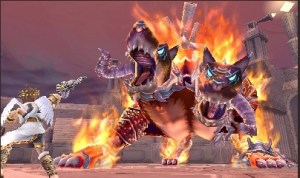Okay, can we take a look at the game in here?
So, I’ve really boiled down the controllers to three very pure and concentrated control inputs, and that’s L button for shooting, the slide pad for character movement and then the stylus is on the touch screen for reticule and camera movement.
You know how in FPS games that are played a DS you are forced to change your camera or your aim by moving from left to right, for example, to the edge of the screen and having to repeat that over and over and over again? That was quite an inconvenient system soo this time we’re implementing flick control for quicker turns. There are other such controls that I won’t go into, but overall it’s a very seamless control of the screen.
The depth-of-field is really amazing; it feels like far away inside of the screen. Speaking of that, was there a desire to make things bigger? Pit hasn’t been in a game for almost 20 years and the last time he was 2D. So, was there like a pressure to make a very big game to meet big expectations?
You mean like the spaces that we play inside or the overall scale of the game?
A little bit of both.
One thing that I was slightly concerned about–and I don’t know how much this is going to answer your question–was as far as using the 3D for depth. This is the first major device to be focused around 3D and it’s a small portable system and there is, after all, some slight concern about how it might strain your eyes after playing for too long.
So, with this in mind and also considering this is a portable device, I wanted to make a very dense play experience combined into this air battle/land battle/boss battle system that it does sort of chop up the experience into shorter sections. And, you know, I like open-world games; they’re one of my favorite genres and I appreciate that kind of experience. But, I also think that considering the portable platform and the 3D screen, I like to keep it a very concentrated impact for dense play experience over a limited time as far as the scale of the game.
Speaking of open-world game and different genres, what do you think of the state of creativity in games today? People always talk about Western development versus Japanese development. Do you see a big difference there and, if so, what do you feel like each section does well?
As far as creativity, in designing Kid Icarus, I took a look at what I thought was an overriding problem with a lot of game design. I’ve found that, in the established genres, the controls are always the same. For example, in shooting games, you find first-person-shooters utilize all of the buttons on the controller and always do the same thing the stick is for moving, triggers for shooting and they’re always trapped in this very restricted framework for gameplay. And, that’s just not creative. It feels like people are taking this empty shell and just swapping out the story and art and whatnot.
This time, with Kid Icarus, we wanted to address that certain problem and not only because I think the industry deserves it, but also because it’s a more satisfying experience personally. And for this different direction, I wanted to take what was a common control system in shooters and get something that was new and smooth and easy for new players, but something that was suitable to the hardware as well. In the same sort of way that fighting games started to feel stale, there was definitely something new to be had in a design like Smash Brothers. That series, I think, was able to allow new players to come in and made it more accessible. There are so many more possibilities for game design out there but I think a lot of developers are shutting out those ideas and it is definitely a creativity problem.
About the difference between Western and Japanese design, there’s really a lot of opinions on this and this is just one of those opinions. But, I feel that Japanese game design and game development really isn’t a good match for the big-budget Hollywood style game experience. There are lot of different factors such as things like the team size and the way development proceeds and is communicated within teams. I mean, there are instances where this trend is more dramatic than others, where teams are either more well-suited to a certain style or not.
Don’t get me wrong: I’m really impressed with Western game design and enjoy a lot of those games. But, personally–and this is something that Nintendo also follows the same philosophy–I trend towards focusing on a gameplay mechanic and working on that mechanic. I start with something that’s very, very simple but is perfected for its gameplay qualities and not try to force it into becoming a larger, more expensive big-budgeted experience. Unfortunately, a lot of developers get caught in trying to out do each other and what ends up becoming is a simple competition in graphics or in scale and whatnot. I think the most important thing–and maybe my overall message for this answer–is that developers just need to focus on what they’re good at. And, while some may be good at these big budget experiences, others are not, and that could be telling of different trends between Western and Japanese game companies.




